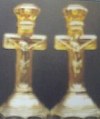Carnival Glass 101 | home Quick Reference to Carnival Glass Patterns on This Site
Dugan - Part 3
DUGAN - Part 3
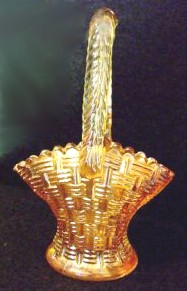 |
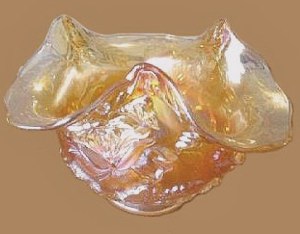 |
BIG BASKETWEAVE Basket Small Size - 3 3/4 in. across x 5 in. tall
|
WREATH of ROSES -
Tri-Corner Whimsey Bowl in Marigold.
|
Both Dugan and Diamond Glass companies used this Big Basketweave pattern as a primary design. It is found on vases, as well as two sizes in handled baskets. It is used as the base design for Persian Gardens two-piece fruit bowl, and as a secondary pattern on the exterior of several different shapes. Possibly the vases are among the most popular shapes for collectors and are known in an extensive number of colors.
BIG BASKETWEAVE Small Basket: is known only in marigold. By clicking on -  - in our pattern index, you can take a look at the differences in this small size and the larger size, already posted.
- in our pattern index, you can take a look at the differences in this small size and the larger size, already posted.
WREATH of ROSES: Fenton used this pattern name for punch sets, two handled, stemmed bonbon and compotes. Dugan placed the same name on their rose bowl, found in amethyst/purple, lime green and marigold, as well as this tri-corner candy bowl in amethyst and marigold. At least one example in a marigold spittoon shape is known. We once owned an amethyst rose bowl with lovely iridescence and regret having sold it. The only beneficial point in selling: it went to satisfy a new collector in San Diego many years ago.
One author reports this tri-corner shape to be rather “common” in marigold; not exciting much interest, but when compared to the “commonality” of such as Peacocks and Good Lucks, the statement lacks basis for truth. Many a carnival glass auction comes and goes without inclusion of this Dugan pattern in any shape. All three shapes are from the same mold.
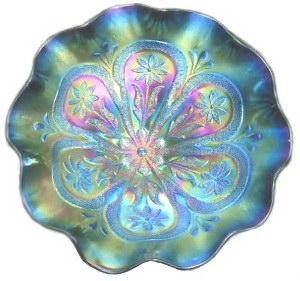 |
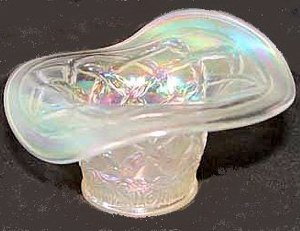 |
FLOWERS & FRAMES 8-9 in. Bowl.
|
GRAPEVINE LATTICE J.I.P. Hat from Tumbler
|
FLOWERS & FRAMES Bowl: An interior surface pattern on dome-footed bowls, this is a relatively scarce Dugan pattern in carnival glass. In March 1910, a line of iridescent ware called Dugan's African Iridescent (oxblood, or black amethyst) was introduced. Bowls having this distinct type coloring are found occasionally, in the Flowers & Frames pattern. Along with ruffled bowls in square shape, some with tightly crimped edge or three and one, there are some 8”-9” triangular shaped bowls to be found. Amethyst and peach opalescent are additional colors known.
GRAPEVINE LATTICE Hat (Jack-in-the-Pulpit): 6”-7” bowls, a 7” plate, a ruffled hat shape and water set are additional shapes within this pattern. Hat shapes are fashioned from the tumbler mold. This (JIP) shaped hat is known in amethyst and white. Ruffled hats are to be found in amethyst and marigold. Neither of the hat shapes are easily found! This pattern spanned the Dugan-Diamond years, first appearing in a spring 1912 issue of Butler Brothers Wholesale Catalog, continuing into the 1920s.
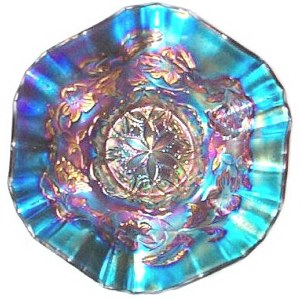 |
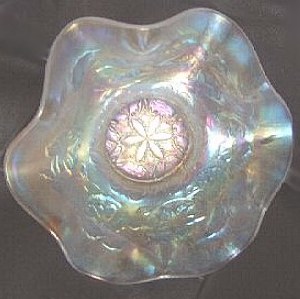 |
SIX PETALS in Purple
|
SIX PETALS in White
|
SIX PETALS: Known in 7”- 8” bowls of ruffled, crimped or triangular shaped bowls, Six Petals is one of the more easily found patterns from Dugan. Since oxblood is one of the colors known, we know that the pattern was included in the production of 1910, when that color was introduced, continuing into 1912 production when Dugan was making their white carnival line. White carnival had only been in production for little more than a month when the February 1912 fire destroyed moulds. Oxblood and marigold bowls are the two most difficult colors to obtain. The triangular shape is quite hard to locate and has only been confirmed in amethyst and peach opalescent. In mid-March 2006 while attending a local auction sale, we handled a perfectly glorious example in true black amethyst! No light could be seen through the glass. The late Roger Gladson could have exercised his penchant for that color, had he been there, but it really did not require his bids to sell for a whopping $184!
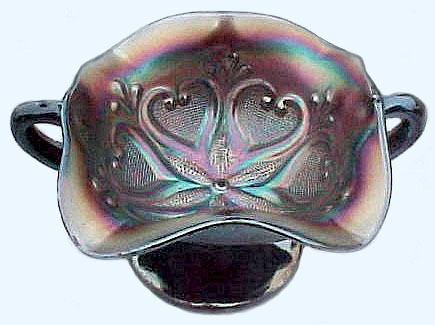
Starfish bonbon
STARFISH Bon-Bon: This stemmed, two-handled bon-bon is the more readily found shape in this pattern. However, the pattern overall, is not plentiful. They are usually quite pretty and well iridized, no matter the color. Here again, marigold is the more scarce color. Comparatively few in numbers-a good indication of Dugan origin. Marigold production from Diamond Glass Co. was more prolific.
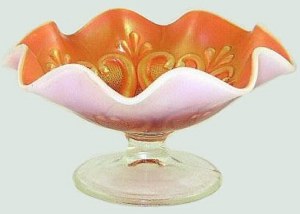 |
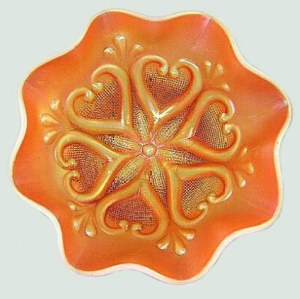 |
STARFISH Compote more difficult to find than a bonbon
|
STARFISH Compote - 6 .25 in. wide x 3.75 in. tall
|
STARFISH Compote: The Starfish design is overlooked, under-appreciated and seldom seen, but dates from the early 1910-1912 Dugan production period. We could not find it offered in any of the 42 Butler Bros. Wholesale Catalogs we gleaned information from for the Reprints in 1994, nor in any later editions purchased. Both the bonbon and the compote are known in marigold, amethyst and peach opalescent.
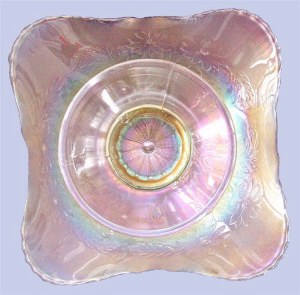 |
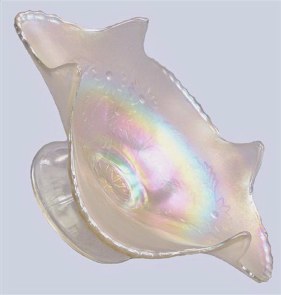 |
WESTERN DAISY in RARE White!(Exterior Pattern.)
|
WESTERN DAISY (a RARE DUDE).
|
WESTERN DAISY: We present this bowl for your appraisal with our distinct pleasure! It is 9” from corner to corner diagonally across the square shape. The photos were taken in natural light, allowing the lovely interior varied pink iridescence to be appreciated.
When the Seeck Auction brochure arrived in Nov. 2005 indicating this rare example to be included in the Bob Bishop Estate Sale, we could not really believe the discovery!! The rare shape alone creates wonder that it has survived the generations without breakage. This base mold is only occasionally found with the Soutache interior design. Most often Soutache is accompanied by a round-edge-dome footed base mold. This Western Daisy exterior pattern was revived from opalescent glass production and appears in the 1907 Dugan factory catalog. With emergence of this white example, we now know that it must have been among some of the earliest moulds used for carnival. Their rarity indicates the strong possibility that the mould did not survive the 1912 fire.
After Darlene Grogan of CA found her peach opalescent example back in the `80s, Dean took a photo of it, which appears in the Dugan-Diamond Book by Carl O. Burns. Darlene brought the bowl to a Club meeting, and it was the first any of us had seen at that time. That example is more or less flat across the top, with the points extended outwards.
Another peach opalescent example was listed in the Bishop sale, but we concentrated on winning the bid for this white example. (Someone else in the crowd realized its rare quality. Isn't that usually the case? - smile) We now know that Dugan used the mold again in their 1912 white line of designs, but the production must have been quite limited. So far as our research indicates, this is the first and only example which has ever appeared for sale at auction during our more than 30 years in carnival glass circles.
We know that there are those who value their multi-thousand-dollar pieces of carnival glass, but we believe that true collectors will fully appreciate our inner joy with owning an extremely rare and equally valuable (in terms of historic and collector satisfaction); this quite remarkable example! ( Many times over, in collecting Carnival Glass, value cannot, nor should it be, calculated in mere terms of dollar investment!) Beauty is in the eye of the beholder and not in what someone else recommends as “collectible”! Collecting for “heartfelt pleasure”, rather than how much dollar profit is possibly in the offing is valid enough reason for purchase. Long experience dictates: the more personal knowledge attained by collectors, the better-suited they become in analyzing the rarest of examples! Not all great pieces need be in the “thousands- of-dollars-category!”
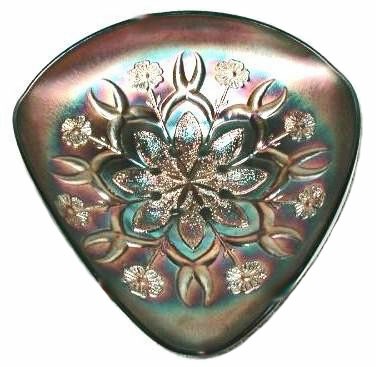
WISHBONE & SPADES. This unusual tri-corner
bowl was shaped from the 11 in Bowl-Plate shape
WISHBONE & SPADES - Triangular Bowl: Among the chop plate-10”-11” and small plate-6”-7” sizes, ruffled bowls of 5'-6” and 9”-10”, there are ice cream bowls-10” in size and all are known in amethyst and peach opalescent. Banana-shaped bowls 9”-10” in size are known in peach opalescent. These triangular bowls, 9”-10” have been confirmed in peach opalescent. At this writing, we are happy to confirm the existence of that shape in amethyst. The pattern dates to c.1911.
Dean & Diane Fry - 7/06
      |
|
A BIBLICAL NOTE: The name Hosea is the same as the name Joshua (in the Old Testament) and Yeshua (in the New Testament), the English name for Jesus. It is significant that the prophet who became a vivid picture of the love of God would bear the same name as the Saviour, who came as the ultimate expression of that love.
|
|
“You through Your commandments, make me wiser than my enemies” (Psalm 119:98). “Do good to them who hate you” (Matthew 5:44), “Speaking the truth in love” (Ephesians 4:15), “Be angry, and do not sin” (Ephesians 4:26). Scripture often offers us wisdom in dealing with difficult relationships.
|
|
      |
Should you care to contact the Frys, their email address is:
Search Our Sites
back to Carnival Glass 101
Our other sites you may enjoy:
Everything you EVER wanted to know about Indiana Glass
Great Reference for Newer Carnival Glass.
Complete Glassware Catalogs Available to Download
Questions? Comments? Suggestions? Broken Links? Corrections?
Your Friendly Webmaster is here to help!
